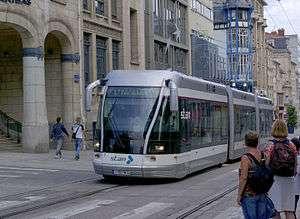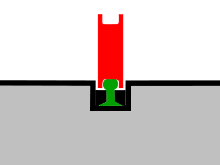Rubber-tyred trams



A development of the guided bus is the tramway on tyres, in which a vehicle is guided by a fixed rail in the road surface and draws current from overhead electric wires (either via pantograph or trolley poles).
Two incompatible systems using physical guide rails exist, the Guided Light Transit (GLT) designed by Bombardier Transportation, and the Translohr from Lohr Industrie (currently made by Alstom and FSI). There are no guide bars at the sides but there is a central guidance rail that differs in design between the systems. In the case of Translohr, this rail is grasped by a pair of metal guide wheels set at 45° to the road and at 90° to each other. In the GLT system, a single double-flanged wheel between the rubber tires follows the guidance rail. In both cases, the weight of the vehicle is borne by rubber tires to which the guide wheels are attached. Power is usually supplied by overhead lines, rechargeable batteries, or internal combustion engines where there are no overhead wires.
The Translohr system operates as a guided vehicle at all times, while with the Bombardier system the vehicles can be driven autonomously as requirements dictate, such as journeys to the depot. Consequently, the Bombardier vehicles are legally considered buses, and must bear rear-view mirrors, lights and number plates, and are controlled with steering wheels and pedals like ordinary buses, though the steering wheel is not used when following the guidance rail. On the other hand, Translohr vehicles operate like standard trams and cannot move without guidance, so it is not classified as a bus and are not equipped with number plates.
These systems are intended to offer a more tram or light rail-like experience than a regular guided bus, and offer some advantages over steel-wheeled trams, such as a potentially smaller turning radius, the ability to climb steeper gradients (up to 13%), and quieter running around corners. The infrastructure installation can be less complicated than the installation of a complete tram line in an existing street. These systems have been likened to the tram equivalent of rubber-tyred metros, and they are also less efficient than steel-wheeled light rail vehicles. There is no evidence to prove the superiority of either guidance system. Both Bombardier and Translohr have had derailments during operation.[1][2]
See also
References
- ↑ "Further problems in Nancy". LRTA. November 20, 2002. Retrieved 18 July 2016.
- ↑ "The first modern guided tramway in China derails (国内首条现代导轨电车出轨)" (in Chinese). news.qq.com. August 20, 2007.
